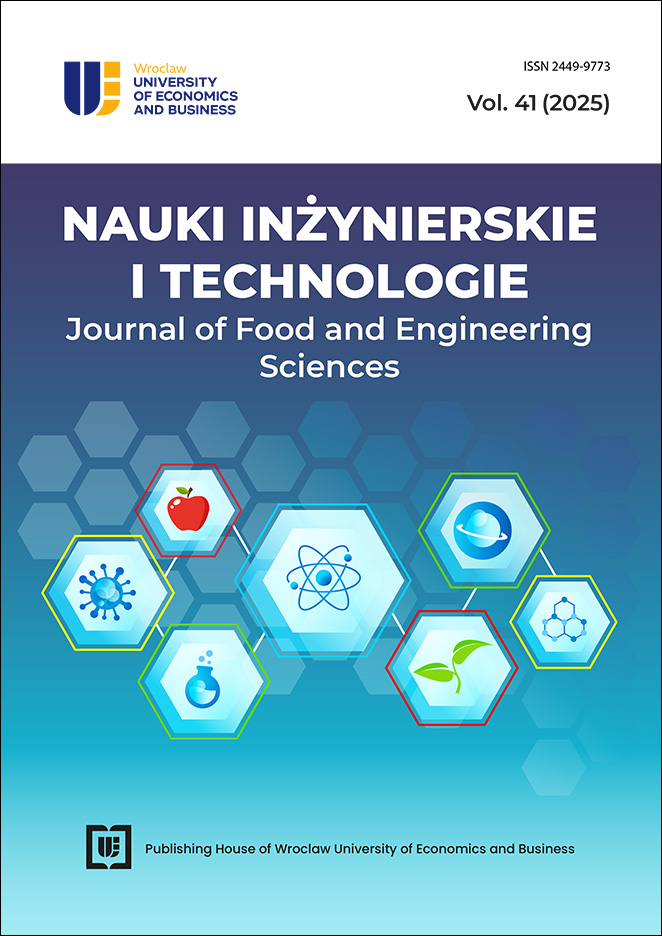Białka pozyskiwane z alg Dunaliella salina i ich zastosowanie w procesach żelowania i wiązaniu metali na tle białka z roślin strączkowych
DOI:
https://doi.org/10.15611/nit.2025.41.04Słowa kluczowe:
białko roślinne, Dunaliella salina, mikroalgi, żelowanie białekAbstrakt
Aim: Identification of research gap regarding the functional properties of microalgal proteins, specifically Dunaliella salina. The analysis aimed to determine whether these microalgal proteins exhibit similar properties to proteins from the following legumes: soybeans, lentils, chickpeas, and peas. The focus was on two key functional characteristics, i.e. gelation properties and metal binding properties.
Methodology: The analysis was based on a review of the scientific literature using the Mendeley database. The search included English-language keywords related to legume proteins and Dunaliella salina, particularly their functional properties. The selected publications were divided into two main thematic groups, namely protein composition and fractions, and their gelling and metal-binding capacity. Additionally, a quantitative analysis of the obtained results was performed to assess the research intensity for each species.
Results: A significant disparity in data availability was demonstrated between legumes and D. salina. While proteins from soybeans, peas, lentils, and chickpeas have been thoroughly characterised in terms of their function, the literature on Dunaliella salina is limited to general information on protein content and some studies on bioactive peptides. However, studies on the ability of these proteins to form gels and bind heavy metals are lacking, hence the results indicate a knowledge gap in this area.
Implications and recommendations: The identified research gap highlights the need for in-depth experimental studies on the functionality of D. salina proteins. It is recommended to evaluate their gelling properties and metal-binding capacity, and the findings of such studies could have applications in the food industry. The potential of microalgae as an alternative protein source warrants further research.
Originality/value: This work contrasts the functional properties of legume proteins with the limited knowledge of Dunaliella salina proteins. It identifies a research gap in the area of microalgae as a potential source of functional proteins. It provides a basis for planning further studies on D. salina proteins in the context of their suitability for food applications.
Pobrania
Bibliografia
Basyigit, B., Altun, G., & Karaaslan, M. (2024). Synthesizing Mechanically Robust Natural Pea Protein Hydrogels via Deep Cryogenic Treatment: State of the Art in Bioactive Compound Celivery System. Food Hydrocolloids, 146(A), 109202. https://doi.org/10.1016/j.foodhyd.2023.109202
Boukid, F. (2021). Chickpea (Cicer arietinum L.) Protein as a Potential Plant-Based Ingredient. International Journal of Food Science and Technology, 56(11), 5435-5444. https:/doi.org/10.1111/ijfs.15046
Cabodevila, O., Hill, S. E., & Mitchell, J. R. (1994). Gelation Enhancement of Soy Protein Isolate Using the Maillard Reaction and High Temperatures. Journal of Food Science, 59(4), 872-875. https://doi.org/10.1111/j.1365-2621.1994.tb08147.x
Capraro, J., Session, F., & Duranti, M. (2015). Proteolytic Cleavage at Twin Arginine Residues Affects Structural and Functional Transitions of Lupine Seed 11s Storage Globulin. PLoS ONE, 10(2). https://doi.org/10.1371/journal.pone.0117406
Chen, Y., Wang, T., & Xie, F. (2022). Effect of Moderate Electric Fields on the Structural and Gelation Properties of Pea Protein Isolate. Innovative Food Science and Emerging Technologies, 77, 102959. https://doi.org/10.1016/j.ifset.2022.102959
Choukri, H., Hejjaoui, K., El-Baouchi, A., El Haddad, N., Smouni, A., Maalouf, F., Thavarajah, D., & Kumar, S. (2020). Heat and Drought Stress Impact on Phenology, Grain Yield, and Nutritional Quality of Lentil (Lens culinaris Medikus). Frontiers in Nutrition, 7. https://doi.org/10.3389/fnut.2020.596307
Comfort, S., & Howell, N. K. (2002). Gelation Properties of Soya and Whey Protein Isolate Mixtures. Food Hydrocolloids, 16(6), 661-672. https://doi.org/10.1016/S0268-005X(02)00033-4
Cornet, R., Penris, S., & van der Linden, E. (2021). How Pea Fractions with Different Protein Composition and Purity Can Substitute WPI in Heat-Set Gels. Food Hydrocolloids, 120, 106891. https://doi.org/10.1016/j.foodhyd.2021.106891
De Berardinis, L., Plazzotta, S., & Manzocco, L. (2023). Optimizing Soy and Pea Protein Gelation to Obtain Hydrogels Intended as Precursors of Food-Grade Dried Porous Materials. Gels, 9(1), 62. https://doi.org/10.3390/gels9010062
De Souza Celente, G., de Cassia de Souza Schneider, R., Rizzetti, T. M., Lobo, E. A., & Sui, Y. (2024). Using Wastewater as a Cultivation Alternative for the Microalga Dunaliella Salina: Potentials and Challenges. Science of the Total Environment, 911, 168812. https://doi.org/10.1016/j.scitotenv.2023.168812
Dionisio, G., Uddin, M. N., & Vincze, E. (2018). Enrichment and Identification of the Most Abundant Zinc Binding Proteins in Developing Barley Grains by Zinc-IMAC Capture and Nano LC-MS/MS. Proteomes, 6(1), 3. https://doi.org/10.3390/proteomes6010003
Farshi, P., Mirmohammadali, S. N., & Li, Y. (2024). Pea Protein and Starch: Functional Properties and Applications in Edible Films. Journal of Agricultural and Food Research, 15, 100927. https://doi.org/10.1016/j.jafr.2023.100927
Garcia, M. C., Torre, M., & Laborda, F. (1997). Composition and Characterization of Soyabean and Related Products. Critical Reviews in Food Science and Nutrition, 37(4), 361-391. https:/doi.org/10.1080/10408399709527779
Geiken, B., Masojídek, J., & Giardi, M. T. (1998). Incorporation of [35S]methionine in Higher Plants Reveals that Stimulation of the D1 Reaction Center II Protein Turnover Accompanies Tolerance to Heavy Metal Stress. Plant, Cell and Environment, 21(12), 1265-1273. https://doi.org/10.1046/j.1365-3040.1998.00361.x
Guidi, S., Formica, F. A., & Denkel, C. (2022). Mixing Plant-Based Proteins: Gel Properties of Hemp, Pea, Lentil Proteins and Their Binary Mixtures. Food Research International, 161. https:/doi.org/10.1016/j.foodres.2022.111752
Jo, Y. J., & Chen, L. (2023). Gelation Behavior of Lentil Protein Aggregates Induced by Sequential Combination of Glucono - δ-Lactone and Transglutaminase. Food Structure, 36, 100312. https://doi.org/10.1016/j.foostr.2023.100312
Jo, Y. J., Huang, W., & Chen, L. (2020). Fabrication and Characterization of Lentil Protein Gels from Fibrillar Aggregates and the Gelling Mechanism Study. Food and Function, 11, 10114-10125. https://doi.org/10.1039/D0FO02089C
Joshi, M., Adhikari, B., Aldred, P., Panozzo, J. F., & Kasapis, S. (2011). Physicochemical and Functional Properties of Lentil Protein Isolates Prepared by Different Drying Methods. Food Chemistry, 129(4), 1513-1522. https://doi.org/10.1016/j.foodchem.2011.05.131
Kornet, R., Penris, S., & van der Linden, E. (2021). How Pea Fractions with Different Protein Composition and Purity Can Substitute WPI in Heat-Set Gels. Food Hydrocolloids, 120, 106891. https://doi.org/10.1016/j.foodhyd.2021.106891
Li, L., Huang, Y., Liu, Y., Xiong, Y., Wang, X., Tong, L., & Wang, F. (2023). Relationship between Soybean Protein Isolate and Textural Properties of Texturized Vegetable Protein. Molecules, 22(28), 7465. https://doi.org/10.3390/molecules28227465
Loris, R., van Overberge, D., & Wyns, L. (1994). Structural Analysis of Two Crystal Forms of Lentil Lectin at 1.8 Å Resolution. Proteins: Structure, Function, and Bioinformatics, 20, 330-346.
Moreno, H. M., Tovar, C. A., & Borderias, A. J. (2020). Gelation of Commercial Pea Protein Isolate: Effect of Microbitransglutaminase and Thermal Processing. Food Science and Technology (Brazil), 40(4), 800-809. https://doi.org/10.1590/fst.19519
Mukhamedov, N., Mirzaakhmedov, S. Y., & Yili, A. (2022). Zinc-Binding Peptides from Protein of Cicer Arietinum. Chemistry of Natural Compounds, 58, 86-89.
Osemwota, E., Alashi, A., & Aluko, R. (2021). Comparative Study of the Structural and Functional Properties of Membrane-Isolated and Isoelectric pH Precipitated Green Lentil Seed Protein Isolates. Membranes, 11(9), 694. https://doi.org/10.3390/membranes11090694
Papalamprou, E. M., Doxastakis, G. I., & Kiosseoglou, V. (2009). Influence of Preparation Methods on Physicochemical and Gelation Properties of Chickpea Protein Isolates. Food Hydrocolloids, 23(2), 337-343. https://doi.org/10.1016/j.foodhyd.2008.03.006
Plocina, L., & Beitane, I. (2024). Study of Amino Acid Profile and Solubility of Pea Protein Isolate for the Production of Beverages for Psychiatric Patients. Rural Sustainability Research, 51(346), 94-102.
Reinecke, H., Dunemann, L., & Schwedt, G. (1989). Polarographische Untersuchungen zur Bestimmung der Stabilität von Metall-Protein- Bindungen / Polarographic Investigations for the Determination of the Stability of Metal-Protein Bonds. Zeitschrift für Naturforschung B, 44, 767-771. https://10.1515/znb-1989-0708
Reynaud, Y., Lopez, M., & Dupont, D. (2020). Hydrolysis of Plant Proteins at the Molecular and Supra-Molecular Scales during In Vitro Digestion. Food Research International, 134, 109204. https://doi.org/10.1016/j.foodres.2020.109204
Robert, S., & Linn Ko, T. (2017). Isolation of Protein from Defatted Lentil Flour. American Journal of Food Science and Technology, 5(6), 238-244.
Rodriguez, Y., & Beyrer, M. (2023). Impact of Native Pea Proteins on the Gelation Properties of Pea Protein Isolates. Food Structure, 37, 100340. https://doi.org/10.1016/j.foostr.2023.100340
Sharma, H., Ramawat, N., & Gupta, C. (2022). Nutritive Content of Lentil. Journal of Nutritional Health & Food Engineering, 12(1), 27-32.
Shrestha, S., van 't Hag, L., & Dhital, S. (2023). Lentil and Mungbean Protein Isolates: Processing, Functional Properties, and Potential Food Applications. Food Hydrocolloids, 135, 108142. https://doi.org/10.1016/j.foodhyd.2022.108142
Shoaib, A., Nafisa, S., & Iqbal, N. (2022). Fourier-Transform Infrared Spectroscopy Identified Changes in the Cell Wall Components Associated with the Simultaneous Trafficking of White Mold Fungus and Copper. Pakistan Journal of Phytopathology, 34(2), 193-200.
Sui, Y., Mazzucchi, L., Acharya, P., Xu, Y., Morgan, G., & Harvey, P. J. (2021). A Comparison of β-carotene, Phytoene and Amino Acids Production in Dunaliella Salina DF 15 (CCAP 19/41) and Dunaliella Salina CCAP 19/30 Using Different Light Wavelengths. Foods, 10(11), 2824. https://doi.org/10.3390/foods10112824
Sumeyra, O., Asli Can, K., Beraat, O., Abdulhakeem, S., & Salam, A. I. (2022). Exploring the Amino-Acid Composition, Secondary Structure, and Physicochemical and Functional Properties of Chickpea Protein Isolates. ACS Omega, 8, 1486-1495.
Sun, X. D., & Arntfield, S. D. (2012). Gelation Properties of Myofibrillar/Pea Protein Mixtures Induced by Transglutaminase Crosslinking, Food Hydrocolloids, 27(2), 394-400. https://doi.org/10.1016/j.foodhyd.2011.11.001
Tavallaie, S., Emtyazjoo, M., Rostami, K., Kosari, H., & Assadi, M. M. (2015). Comparative Studies of β-carotene and Protein Production from Dunaliella Salina Isolated from Lake Hoze-Soltan, Iran. Journal of Aquatic Food Product Technology, 24(1), 79-90. https://doi.org/10.1080/10498850.2012.759634
Wan, X., & Freisinger, E. (2009). The Plant Metallothionein 2 from Cicer Arietinum Forms a Single Metal-Thiolate Cluster. Metallomics, 1(6), 489-500. https://doi.org/10.1039/B906428A
Wang, T., Hou, G., Wang, Y., & Xue, L. (2010). Characterization and Heterologous Expression of a New Matrix Attachment Region Binding Protein from the Unicellular Green Alga Dunaliella salina. Journal of Biochemistry, 148(6), 651-658. https://doi.org/10.1093/jb/mvq100
Xia, E., Zhai, L., & Tang, H. (2019). Optimization and Identification of Antioxidant Peptide from Underutilized Dunaliella Salina Protein: Extraction, In Vitro Gastrointestinal Digestion, and Fractionation. BioMed Research International. https://doi.org/10.1155/2019/6424651
Zhang, T., Jiang, B., & Wang, Z. (2007). Gelation Properties of Chickpea Protein Isolates. Food Hydrocolloids, 21(2), 280-286. https://doi.org/10.1016/j.foodhyd.2006.04.005
Zhang, Y. Y., Stockmann, R., & Ajlouni, S. (2023). Characterization of Fe(III)-binding Peptides from Pea Protein Hydrolysates. Food Chemistry, 405, 134887. https://doi.org/10.1016/j.foodchem.2022.134887
Pobrania
Opublikowane
Licencja
Prawa autorskie (c) 2025 Rafal Szewczyk

Utwór dostępny jest na licencji Creative Commons Uznanie autorstwa – Na tych samych warunkach 4.0 Miedzynarodowe.





